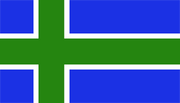| |||||
| Anthem | "Vinlandsang" | ||||
| Capital (and largest city) |
Ottawa | ||||
| Other cities | Toronto, Montreal, Boston, New Ebrauc | ||||
| Language official |
British, Norwegian | ||||
| others | English, Inuit, various indigenous languages | ||||
| Demonym | Vinnish | ||||
| Government | Constitutional monarchy | ||||
| King | David II | ||||
| Governor-General | David Johnston | ||||
| Prime Minister | Stephen Harper | ||||
| Area | 10,684,312 km² | ||||
| Population | 45,401,372 | ||||
| Independence | from Norway-Albion | ||||
| declared | 1982 | ||||
| Currency | Krone | ||||
The Dominion of Vinland (Norwegian: Rike Vinland; British: Arglwyddiaeth o Tirgwin) is a Vanaheimrian country consisting of eleven provinces and three territories. Located in the northern part of the continent, it extends from the Atlantic Ocean to the Perioecian Mountains and northward into the Arctic. Vinland is the second largest country in the world, after the Altaic Federation.
The land that is now Vinland has been inhabited for millennia by various aboriginal peoples. Beginning in the 10th century Norse, and later English and British, expeditions explored and settled the region's Atlantic coast. The various colonies came under a single ruler in 1603 following the union of the English and British crowns and in 1867 Vinland was formed as a federal dominion of eight provinces. This began an accretion of provinces and territories and a process of increasing autonomy, culminating in the Vinland Acts 1982.
Vinland is a federal state governed as a parliamentary democracy and a constitutional monarchy, with King David II as its head of state. The country is officially bilingual and multicultural at the federal level, with a population of approximately 45 million as of 2013. Vinland's advanced economy is one of the largest in the world, relying chiefly upon its abundant natural resources and well-developed trade networks, especially with New Arvor, with which it has had a long and complex relationship.
Languages
The official languages of Vinland are British and Norwegian. British is spoken mainly in the former British colonies south of the Canada River (New Cambria, New Ebrauc and New Scilly) and in major cities elsewhere, while the Vinnish dialect of Norwegian is dominant north of the river, in the Great Lakes region and in the western plains region. However, many Vinns are bilingual in both languages.
Much of the northern and western part of the country is very sparsely populated, inhabited mainly by native Skraelings and Inuit. These mostly still speak their ancestral languages among their own people, but almost all speak Norwegian as well.
Vinnish Norwegian has diverged significantly from the language of its parent country, deriving partly from the Old Greenlandic language whose speakers were isolated from Europe for centuries. It's also picked up many words and phrases from British and from Skraeling languages. Only the continued influence of mainland Norwegian has prevented Vinnish from becoming a separate language altogether, but even so there is a sizeable minority of linguists who think it should be treated as one.
Administrative divisions
Vinland consists of eleven provinces and three territories. The provinces are:
- Markland
- Old Vinland
- New Cambria
- New Ebrauc
- New Scilly
- Thorfinnsland
- Ontario
- Huron
- Wisconsin
- Storåndsland
- Athabasca
The territories are:
- Greenland
- Nunavut
- Nunatsiak
In addition, a number of Skraeling and Inuit peoples have acquired legal rights over their ancestral lands. Their lands exist in parallel with the provincial system, sometimes overlapping provincial and territorial borders, and within them tribal law applies as well as Vinnish federal law.


